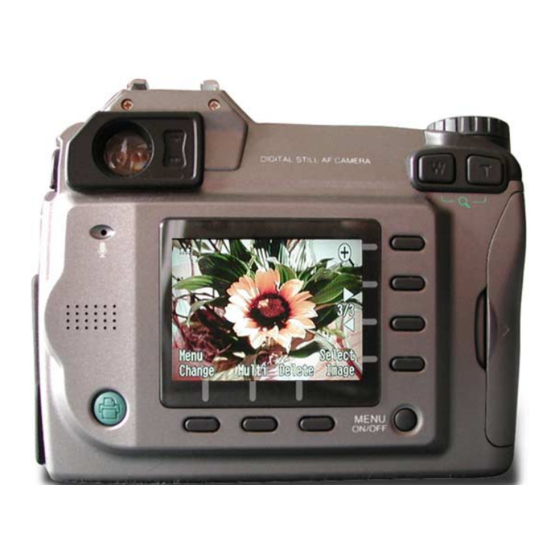
Epson PhotoPC - Color Digital Camera Technical Brief
Technical brief (digital cameras)
Hide thumbs
Also See for PhotoPC - Color Digital Camera:
- User manual (63 pages) ,
- Specifications (1 page) ,
- User manual (74 pages)
Advertisement
Quick Links
Download this manual
See also:
User Manual
Contents
This technical brief provides detailed information on the following topics, related to all EPSON digital cameras:
Image quality
Ease of Use
Versatility
Image Quality—Megapixel CCD sensors
EPSON digital cameras include a one megapixel, two megapixel, or three megapixel CCD sensor, which
determines the resolution of the images. Each megapixel contains one million pixels.
A CCD is made up of an array of photosensors (CCD elements or
photosites) that are able to record a unique image detail. Each
photosensor (or CCD element) creates an electrical charge
proportional to the amount of light it receives and sends the charge to
an A/D (Analog to Digital) converter inside the camera.
Because a higher resolution image contains more detail, you can:
Enlarge an image without losing a significant amount of detail.
Print an image to a high resolution output device (such as an
EPSON Stylus ink jet printer or a printing press)—many
industry analysts believe that the quality of images captured
with two megapixel digital cameras is good enough to replace
traditional film-based cameras.
The key differences between a one megapixel, two megapixel, and three megapixel CCD sensor are:
Ideal use for images
with low compression
One, two, and three megapixel cameras produce excellent 4 x 6-inch and 5x7-inch prints. The key
difference lies in the quality of the image enlargements.
EPSON Sales Training
Megapixel CCD sensors
M
HyPict™ Image Enhancement Technology
M
Multiple resolution modes
M
M
EPSON ClearOptics Glass Lens
Image storage
M
M
Color LCD monitor
M
Full automatic to manual controls
File uploads and video output
M
M
Voice recording
M
Picture modes
M
PRINT Image Matching™ technology
Key Differences
One Megapixel CCD
1152 x 864 pixels (1.09
Image resolution
million pixels CCD)
1280 x 960 pixels (1.25
million pixels CCD)
Up to 5 x 7 inch
enlargements
EPSON and EPSON Stylus are registered trademarks and Print Image Matching is a
trademark of Seiko Epson Corporation. PhotoPC is a registered trademark of Epson
America, Inc. Other trademarks are the property of their respective owners.
Higher resolution produces greater detail
Two Megapixel CCD
1600 x 1200 pixels
Up to 8 x 10 inch
enlargements
Three Megapixel CCD
2048 x 1536 pixels
Up to 11 x 14 inch
enlargements
5/01
Advertisement

Summary of Contents for Epson PhotoPC - Color Digital Camera
- Page 1 Contents This technical brief provides detailed information on the following topics, related to all EPSON digital cameras: Image quality Megapixel CCD sensors HyPict™ Image Enhancement Technology Multiple resolution modes EPSON ClearOptics Glass Lens Ease of Use Image storage Color LCD monitor...
- Page 2 Image quality—Resolution modes EPSON digital cameras allows you to select different image quality settings. (Not all of these settings are available for each model.) The following chart explains the differences between the image quality settings: Key Differences HyPict™...
- Page 3 Image Quality—EPSON ClearOptics™ glass lens EPSON digital cameras all use an EPSON ClearOptics glass lens, but the specific type of lens differs by camera model. For example, the lens on the low-end model may include an aspherical glass lens with five elements in...
- Page 4 Clik! disk, then transfer images from the Clik! disk to your PC using the desktop docking station. Ease of Use—Color LCD monitor EPSON digital cameras allows you to take pictures using the viewfinder or the color LCD. Using the LCD gives you the following advantages:...
- Page 5 Versatility—File upload and video output Most EPSON digital cameras allow you to upload presentations, images, and programs to the camera and then connect the camera directly to a video output device, such as a television, VCR or multimedia projector.
- Page 6 Page 5 Versatility—Voice recording Several EPSON digital cameras have built-in microphones which allow you to record a voice message for each image, right on the camera. Some cameras also have a built-in speaker so you can also listen to the message right on the camera.
- Page 7 Optical zoom uses a lens system to magnify image with no loss of image quality. Many EPSON cameras have a 3X optical zoom lens that can be combined with the 2X digital zoom for a maximum 6X zoom. 2. Quick shot—This picture mode saves up to 10 standard, fine, or super fine images in temporary storage while you keep taking pictures.
- Page 8 (future printers will have this feature, and many current models will have updated drivers available to support it) and the EPSON PhotoPC 3100Z is the first EPSON digital camera to incorporate this technology. PRINT Image Matching offers a solution to several problems when printing digital images: Because software programs set their own unique print commands, it has been difficult to get accurate prints on a consistent basis when printing digital camera images.


